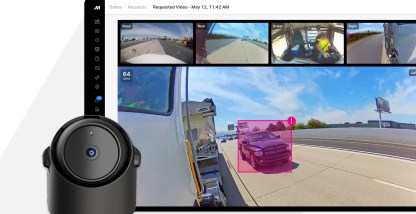Your business likely has a fleet safety program with formalized policies and procedures, regular communication, consistent training, and personal accountability. But you could still be missing an essential component. So how can you make sure your fleet safety program is successful? Don’t underestimate the value of engaging leadership. This article shares the connection between leadership and the long-term success of your safety program.
Search online for information about what makes a successful fleet safety program and you’ll get several lists back. There’s an abundance of ideas about how to develop a culture that supports safety. Frequent suggestions include:
- Setting and communicating goals
- Recognizing and rewarding positive behaviors
- Getting your drivers involved
- Evaluating the program on an ongoing basis
- Soliciting driver feedback into the safety program
While these steps can help support workplace and driver safety, they don’t sufficiently highlight the importance of an engaged culture. According to Gallup research, prioritizing employee engagement helps decrease absenteeism (81%) and employee turnover (18% for high turnover organizations). It can also result in 64% fewer safety incidents.
Cutting your safety incidents by 64% can benefit your business in many ways. Decreasing accidents can reduce insurance costs and increase Compliance, Safety and Accountability (CSA) scores. High insurance premiums cut into your bottom line. Low CSA scores can lose you business as shippers and 3PLs often look at CSA score data when choosing carriers.
These examples alone demonstrate the value of fleet safety. But, how does driver engagement correlate with safety? We’ll discuss that in more detail next.
Engaging leadership and your fleet safety program
Overall workplace culture plays a major role in reaching your business goals. Engaging leaders are key to establishing the culture you want. Research shows over and again that disengaged employees are less likely to work hard, feel motivated, or meet business expectations. These behaviors decrease productivity and profitability, but also undermine your safety initiatives.
Yet engaging leaders are more likely to earn employee trust and commitment. With engaging leaders at the helm:
- People listen when the importance of safety is communicated
- Employees are more likely to accept responsibility and admit mistakes
- Collaboration on decisions to improve safety
- Employees take action to sustain a successful safety program
- There’s more feedback and recognition to ensure consistency
All of these work together to create a positive culture where your drivers voluntarily do what they can to live up to safety expectations.
A professor at Harvard’s T.H. Chan School of Public Health puts it this way: “Imagine a stick figure without a head. That is a model of transactional leadership — focused on work, tasks, and output.” That’s not engaging leadership. Then, the former Director of Health and Safety Worldwide at Procter and Gamble, says, “Now add a smiley face and a heart to that stick figure. That’s how a transformational leader sees the workforce — as a whole person, with a head and a heart. By engaging the whole worker in the work process, whatever that process is, you end up with a better product.”
Engaging leadership is about establishing mutual self interest. An engaging leader demonstrates, through communication, collaboration, and listening, that they care about more than output. Linking the worker’s needs to the objectives of safety policies and programs, they can encourage excellence.
Scalable safety program implementation best practices
There are many reasons to take action to improve your fleet safety program. Increasing accident rates and liability in addition to rising insurance costs are a financial burden. Damaging your fleet’s reputation in the face of a driver and operator shortage isn’t going to help your recruitment. Plus, there’s simply the ethical importance of embracing safety and protecting people out on the road along with your employees and assets.
These four best practices can help your leaders scale a successful safety program.
1. Coach drivers
Coaching your drivers can improve safety while also increasing their productivity and satisfaction. With an AI-powered dash cam, every kind of transportation company, from big rigs to bulldozers, can use video clips to coach drivers to become safer.
Driver coaching is bound to be more effective when you can rely on timely video evidence and offer instruction in real time. Being specific and using video clips to highlight unsafe behaviors will help the driver better understand how to avoid future risk.
Taking a proactive approach to safety can cut FMCSA-reported crashes, reduce unsafe driving behaviors, and give you a greater return on investment (ROI). In an analysis of over 5,000 fleets across two years, we found fleets that used Motive dash cams and coached using the safety platform saw 10 times the ROI.
2. Retain drivers
Engaged drivers are more likely to stay with your fleet. Combating driver turnover helps you avoid the costs of finding and recruiting new drivers, which is estimated to add up to an industry-wide cost of $2.8 billion per year.
At the same time, reducing driver turnover with driver retention strategies supports safety as well. Drivers that know you and your routes know what to expect and can perform more effectively and efficiently. You will have the opportunity to foster their trust and train them in your specific safety policies and procedures.
3. Optimize back office resources
Simplifying safety management can also help you develop a world-class fleet safety program. The right fleet management software can get your back office personnel some of their time back. You can also cut costs with self-coaching tools, prioritized dash cam footage, and customizable safety definitions. An automated safety solution, integrated with your dash cams, can also provide the tools to identify drivers with risky driving habits and target your driving coaching programs to improve overall fleet safety.
4. See safety in whole new way
Understanding human nature and the role leaders play in creating a culture of care, you’ll want to commit to engaging leadership to make a difference. Expanding safety education and skills can boost your safety program’s success as well. But you can make people feel more confident and responsible by investing in technology that offers accurate, efficient, and comprehensive support for your efforts.
Optimize your fleet safety program with Motive
Maximize fleet safety and minimize risk with Motive’s AI-driven safety platform providing accurate real-time driver coaching, instant accident detection, privacy protection, and on-the-spot exoneration evidence. Streamlining processes through technology and enabling data-driven decision making can also deliver dramatic safety and profitability improvements.
Couple your engaging leadership efforts with Motive’s trusted fleet management software solution to see improved safety and engage more effectively in creating a safety culture. Request a demo or connect with a sales rep today.










